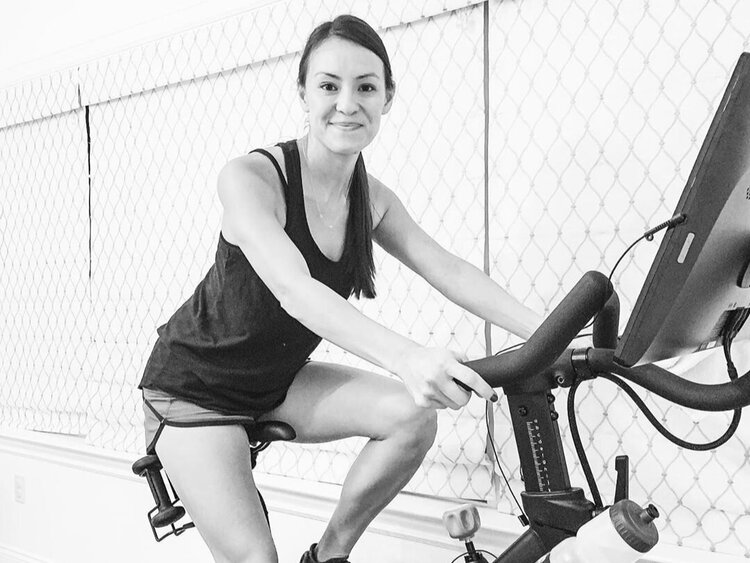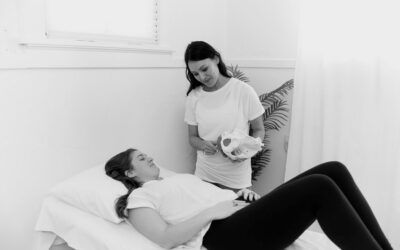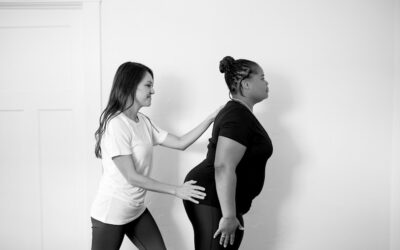I get a lot of questions about using the Peloton postpartum, with prolapse and during pregnancy. Can you use the Peloton during pregnancy? How can you safely use the Peloton during pregnancy? When can you use the Peloton after giving birth? I personally love my stationary bike that goes nowhere, but you know what always doesn’t? My vagina!
When cycling, spinning, motorcycle riding, horseback riding or anything with a saddle, the chronic pressure on the nerves and muscles in your pelvic floor region can cause muscle tension, nerve irritation and lead to pelvic pain. This can show up like vaginal pain, burning, pain with sitting, difficulty emptying your pee or poop, or painful intercourse. All from riding a bicycle! We see this a lot in men too.
If you do a lot of sitting, cycling or Peloton riding and you start experiencing pelvic pain, it could be a pelvic floor muscle issue. I strongly recommend seeing a Pelvic Floor PT to get your pelvic health assessed. Below are some tips to keep your pelvic floor happy when on the saddle.
Check your posture
Your bottom should be slightly back in the seat (which will avoid achy crotch syndrome) and give you power to push those pedals.
Keep your back flat and shoulders back
This will help prevent back pain and decrease pressure on your pelvic floor and abdominals. This is important for women with diastasis recti, prolapse, and early postpartum. Keep your shoulders back to prevent forward head posture, rounded shoulders and neck pain. If you are carrying kiddos around or looking down at your phone often, it is likely already a challenge!
Breathe
As you get fatigued or the intensity of the workout increases, you may have a tendency to hold your breath. This puts increased pressure on your abdominals and pelvic floor which encourages lengthening and weakness. Make sure you are breathing and if it’s too tough and you are holding your breath, turn the resistance down.
Keep your knees in line with your toes
If you have weak booty muscles or tight IT bands, your knees tend to go in toward the midline and the bike. Look down and make sure those knees point straight ahead when cycling.
Move out of the saddle
If you alternate between sitting and standing throughout the workout, you will not only work different muscle groups, but also minimize the tendency to have poor posture.
Take it slow
If you are a postpartum mom, please take it slow on the return. Work on some gentle pelvic floor and deep abdominal wall engagement first, make sure abdominal and perineal incisions are well healed (at least 6 weeks), and start with low intensity and resistance. Just get on for movement and blood flow to start. If pain or bleeding occur afterwards, take a break.
Peloton and Pelvic Floor Weakness
This brings us to pelvic floor weakness, pelvic organ prolapse and returning to cycling after childbirth. If any of this relates to you and you’re a Peloton lover, keep reading!
Breathe
I said it before and I’ll say it again! You will often hear me say “Exhale with Exertion” as that helps manage your intra-abdominal pressure and protect your abdominal wall and pelvic floor from too much pressure. As you are pedaling, practice exhaling as you push down on your pedals. If you feel pressure or heaviness in your pelvic floor, scale back.
Keep your intensity low
If you are postpartum or have known Diastasis Recti or pelvic floor weakness, too much intensity may contribute to more pressure on your tissues. Keep the resistance low and focus on activating your pelvic floor and transverse abdominals and maintaining optimal posture. As you get stronger or less symptomatic, gradually increased resistance.
Stay seated
If you experience pelvic floor weakness, pelvic organ prolapse or vulvar varicosities, then sitting on the saddle will give you added support.
Use support
Compression can be key. If you have prolapse or vulvar varicosities, I recommend using a compressive pelvic support! If you have Diastasis Recti, DO NOT use a waist trainer. Instead, compression leggings or my favorite gentle supports by Bao Bei Maternity are recommended. Monitor your abdominal wall for coning throughout!
Know when to stop
Pain, pressure, peeing your pants or abdominal coning can let you know your form may be off, your intra-abdominal pressure is not optimally managed or its too much intensity and your tissues can’t handle it. Check your form and breathing and if they persist, then scale back.
Peloton and Pregnancy
If you are a Peloton mom or cyclist and want to keep riding during pregnancy, below are my top tips specifically for those expecting. You can (and should!) exercise throughout your pregnancy as you are able.
Use the talk test
You want to be able to “hold a conversation” or talk when exercising. If you are breathless, turn down the resistance and/or take a break.
Breathe
If the workouts are too intense, you may find yourself holding your breath to push the pedals. This can cause too much pressure on your pelvic floor and abs which are already vulnerable. So exhale as you are exerting effort and pushing down those pedals.
Don’t try to PR
Pregnancy is not the time to set a personal best in fitness. Exercise has incredible benefits for mom and baby. You can continue to exercise (recommended 150 minutes of moderate exercise per week) but pregnancy is not an ideal time to train for a major race or up your intensity. Try lower intensity workouts as pregnancy progresses and check in with your medical provider or a Pelvic Floor PT for guidance.
Check your abdominal wall for coning
Many women experience Diastasis Recti/abdominal separation as the midline of ab muscles stretch. Look down and if it looks like a cone or football is coming out of the middle of your belly, turn down the resistance, make sure you are breathing properly or back off completely.
Peeing yourself could mean you need to scale back
Peeing your pants is a sign it’s too much for your pelvic floor. This is not normal so scale back. You can decrease the resistance or wear a tampon or Poise Impressa to support your bladder. The best thing you can do though, is to work with a Pelvic Floor PT.
Adjust your bike
As your belly starts to grow, it may help to raise your handlebars or move your seat forward to keep you upright so your knees aren’t hitting your belly.
Hydrate
You have a lot more blood volume during pregnancy so you need a lot more water to stay hydrated. Drink up!
I hope these tips about riding your Peloton were helpful. As always, check in with a pelvic floor PT if needed, and I’ll see you on the leaderboard!
__________________________________________________________________________________________________________
Interested in more tips on how to prevent or overcome Pelvic Floor Problems?
Download this free guide for some simple, do-able, totally-not-weird tips to take better care of your down there.
_________________________________________________________________________________________________________
Some links may be affiliate links. The products we recommend are products we use or recommend to clients.




